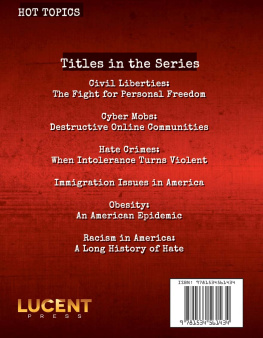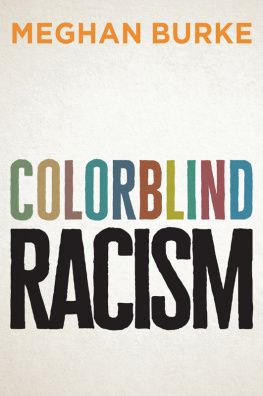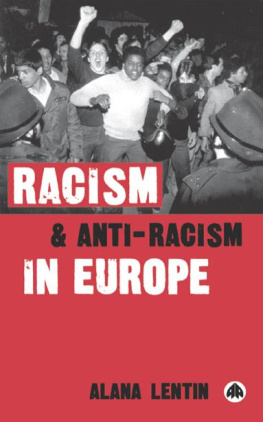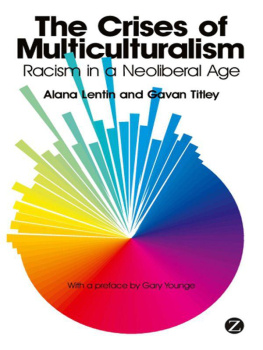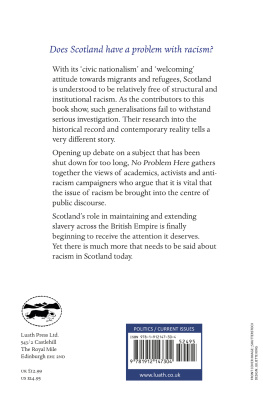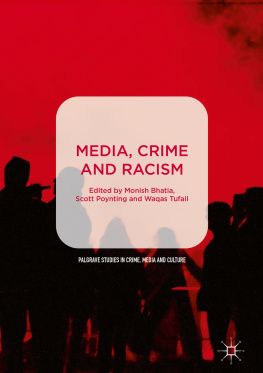Racism and Media addresses one of the major challenges of todays world: the continuing racisms propagated, reproduced and reinforced via different genres and media in many context dependent ways. This book is an excellent, well argued, and comprehensive overview, with several in-depth case studies, which illustrate how pervasive racist attitudes, strategies, and practices have become and how they are disseminated both in formal and informal everyday interactions. A most valuable contribution to media studies, discourse studies, and political science.
Ruth Wodak, Lancaster University
This book is important. It builds on an astonishing array of writers on race and media to develop an original perspective on what it calls the debatability of racism. Its arguments are well illustrated. It is theoretically sophisticated. It is also politically sharp. All thats left is for you to read it.
Ghassan Hage, University of Melbourne
As a scholar and journalist who feels rather familiar with ideas about race, I found this book refreshing and clarifying. It helped me see patterns in the fog of racial claims, to connect developments in the U.S. and Europe and to better understand how change and continuity are unfolding in mediated racial politics. Ultimately, Racism and Media will inform how I craft arguments about the relationship between media and race and how I think about what we are fighting for.
Chenjerai Kumanyika, Rutgers University
Media logics are integrated into the formation of racism which are, as Titley argues, simultaneously everywhere and nowhere in our public culture. In calm and measured prose, he unpicks numerous conceptual issues around postracialism, the domopolitical and Islamophobia, using case materials about the Charlie Hebdo affair, the English Defence League and others. This is a sophisticated contribution to both understanding and acting against the re-emergence of the far Right.
Annabelle Sreberny, SOAS
SAGE Publications Ltd
1 Olivers Yard
55 City Road
London EC1Y 1SP
SAGE Publications Inc.
2455 Teller Road
Thousand Oaks, California 91320
SAGE Publications India Pvt Ltd
B 1/I 1 Mohan Cooperative Industrial Area
Mathura Road
New Delhi 110 044
SAGE Publications Asia-Pacific Pte Ltd
3 Church Street
#10-04 Samsung Hub
Singapore 049483
Gavan Titley, 2019
First published 2019
Apart from any fair dealing for the purposes of research or private study, or criticism or review, as permitted under the Copyright, Designs and Patents Act, 1988, this publication may be reproduced, stored or transmitted in any form, or by any means, only with the prior permission in writing of the publishers, or in the case of reprographic reproduction, in accordance with the terms of licences issued by the Copyright Licensing Agency. Enquiries concerning reproduction outside those terms should be sent to the publishers.
Library of Congress Control Number: 2018964651
British Library Cataloguing in Publication data
A catalogue record for this book is available from the British Library
ISBN 978-1-4462-9853-4
ISBN 978-1-4462-9854-1 (pbk)
Editor: Michael Ainsley
Assistant editor: John Nightingale
Production editor: Imogen Roome
Copyeditor: Aud Scriven
Proofreader: Leigh C. Smithson
Indexer: Adam Pozner
Marketing manager: Lucia Sweet
Cover design: Francis Kenney
Typeset by: C&M Digitals (P) Ltd, Chennai, India
Printed in the UK
At SAGE we take sustainability seriously. Most of our products are printed in the UK using responsibly sourced papers and boards. When we print overseas we ensure sustainable papers are used as measured by the PREPS grading system. We undertake an annual audit to monitor our sustainability.
Preface and acknowledgements
Racism does not stay still; it changes shape, size, contours, purpose, function with changes in the economy, the social structure, the system and, above all, the challenges, the resistance to that system. (Ambalavaner Sivanandan, 1990: 64)
In intensely mediated societies racism stays still less and less, and it is this communicative generativity, and its social and political significance, which is the subject of this book. It is shaped by the general observation that, in many contemporary societies, the extent of public debate and controversy as to what constitutes racism, and who gets to decide, is politically consequential. This is not simply confusion as to the correct meaning of racism, but productive noise, a dimension of how racisms change size, contours and function. Racism, this book argues, is a subject not just of debate but also of what I term debatability, a constant contest as to what counts as racism and whose reality counts in this evaluation, a process that renders it a matter of opinion and speculative churn, not history, experience and power. This general observation is pulled into different shapes and directions depending on particular issues, relations and contexts, but it is based on two factors that intersect in the socio-political contexts under discussion in this book.
The first is socio-political, and can be contingently summarized as a pronounced sense of postracialism. That is, race does not exist, and racism, when it does exist, is defined by its pastness and its extremism, an ignorant or ideological passion, out of time. Given the tendency to measure out international time in US presidencies, it may seem strange to talk of postracialism in a book commenced during Obamas era of hope and completed during Trumps experiment in full-throated racist scapegoating (not to mention in a European conjuncture where anti-migrant and anti-Muslim racism is articulated with increasingly open enthusiasm in polities across the continent). However, as discusses at length, there are many ways of understanding the question of postracialism, and one of them is congruent with the shape-shifting renewals of racism as a political force that Sivanandan insists on in the quotation above.
The second is that of networked digital media systems, and profound and still unfolding shifts in the accelerated and expanded production, distribution and circulation of information, images and artefacts. Under these conditions mediated forms of racialized provocation carry renewed political charge. Intensive media events unfolding around whether an act or a statement actually constitutes racism have become staple rituals of public culture. Racialized meanings and practices have historically been formed both contextually and in networks of international exchange and influence, and digital medias transnational networks of exchange intensify and complicate these dynamics, in spectacular and quotidian ways. While the book argues that these processes often result in enhanced forms of racist force, they are also contingent, and as Sivanandan reminds us, always contested and resisted, including in and through media conditions that bolster and complicate these anti-racist practices.







